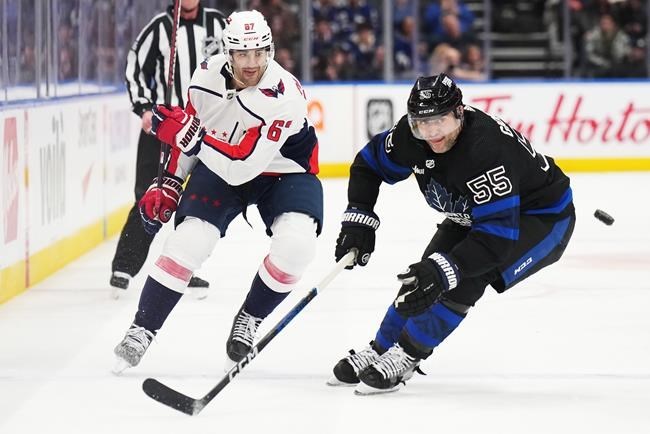Mark Giordano has witnessed the NHL's power-play evolution up close.
The league's oldest player this season at age 40, the Toronto Maple Leafs defenceman quarterbacked the Calgary Flames' No. 1 unit in his Norris Trophy-winning 2018-19 season.
By that time, many power plays had already morphed from the classic setup featuring two defencemen at the point and three forwards around the net to a 1-3-1 formation — usually with another centre or winger — that spread out the opposition and created more avenues to the net.
"Can't keep the skill you have off the power play," Giordano said of the modern man advantage. "But there's way more risk-taking."
The umbrella power-play setup with a player on either flank, one at the point and two closer to the net or in the slot opened up more opportunities. Seams were created with penalty killers stretched into uncomfortable spots.
The Vancouver Canucks once owned one of the league's best power plays thanks to Henrik and Daniel Sedin's wizardry that included the so-called "high tip," while Nazem Kadri scored plenty with the Colorado Avalanche when deployed in the middle of their formation. Some teams have even gone with five forwards at times.
"That's sports … five years from now something new will come," New York Rangers defenceman Adam Fox said. "It's all about creativity and not being stagnant."
Panthers forward Sam Reinhart has been the beneficiary this season of Florida's system, with 27 of his 52 goals coming on the man advantage.
"It's almost like fashion," Nashville Predators winger Filip Forsberg said of different approaches for clubs attacking 5-on-4. "It comes in and people start copying."
That goes both ways as the game has become faster and more skilled up and down NHL rosters.
Penalty killing units were forced to adjust, including moving from a two low, two high box-style setup to a diamond approach aimed at taking away the power play quarterback — usually a skilled defenceman at the top of the formation — and those forwards along the side boards.
"We've seen a real change and a real shift in how teams kill penalties," Leafs head coach Sheldon Keefe said. "That's just the natural yin and yang.
"Keeps it interesting, keeps it fun."
Apart from the diamond response, penalty killing units are also deploying offensive players with defensive acumen while skating short-handed — instead of only using third- and fourth-liners — in hopes generating chances the other way.
Mitch Marner is a big part of the Leafs' penalty kill when healthy. Keefe might also throw NHL-goal leader Auston Matthews over the boards. The Edmonton Oilers have done the same with reigning MVP Connor McDavid.
That threat can manipulate a power play.
"If I know McDavid's out there," Giordano said, "I might not sling that high-risk pass."
Buffalo Sabres centre Tage Thompson said breaking down video has had a huge affect how opponents attempt to thwart power plays.
"Certain teams penalty kill against us different than they would with another," he said. "Definitely makes it harder."
Chicago Blackhawks defenceman Seth Jones came into the league with Nashville when having two defencemen on the man advantage was more the norm.
Times have certainly changed — sometimes with unintended consequences.
"You see a lot more short-handed goals," Jones said.
The shift to higher-risk, higher-reward power plays has also meant fewer opportunities for defencemen that aren't at the absolute top of the offensive ledger.
"But at the same time, the team that does have that elite quarterback, it's noticeable," Forsberg said. "The best power plays in the league have that."
Canucks defenceman Quinn Hughes, who's in that echelon along with Fox, Cale Makar, Roman Josi and Rasmus Dahlin, said it's an endless game of cat and mouse up or down a man.
"Penalty kills are so competitive," he said. "Figure out how to beat the diamond, and then the penalty kill will probably come back with something different."
The threat of McDavid, Matthews, Marner or another star heading the other way short-handed adds yet another layer.
"You're always aware," Giordano said. "If they pick it off, there's no chance."
FITTING IN
Panthers head coach Paul Maurice knew he was getting a goal-scorer in Vladimir Tarasenko when Florida acquired him from the Ottawa Senators ahead of the NHL trade deadline.
Based on his time in the Kontinental Hockey League, Maurice also guessed the Russian winger would be good on the other side of the puck.
"They understand the game defensively very well," said Maurice, who spent the 2012-13 season behind the bench in Tarasenko's homeland. "He's a very, very smart defensive player."
Tarasenko makes his return to Ottawa on Thursday when the Senators host Florida.
This report by The Canadian Press was first published April 3, 2024.
___
Follow @JClipperton_CP on X.
Joshua Clipperton's weekly NHL notebook is published every Wednesday.
Joshua Clipperton, The Canadian Press




